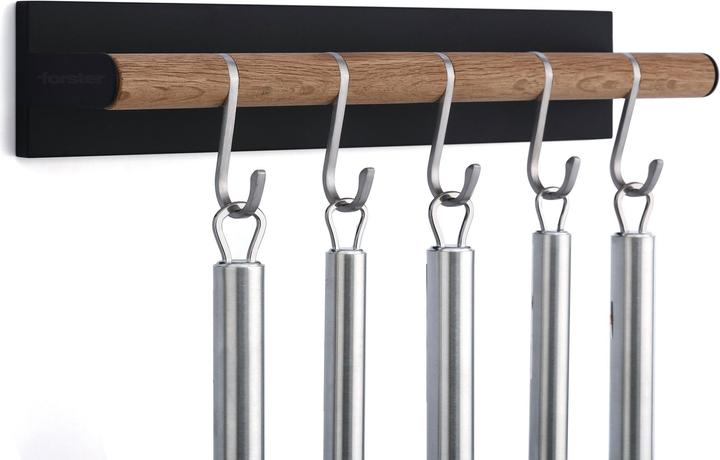

Make room on your kitchen countertop with these accessories
Kitchen accessories from Forster Home are like ninjas – scaling any wall and flashing over to wherever you need them. I visited the production facility to discover the secret of their manoeuvrability.
Picture this: you’re cooking and want to throw some oil in the pan. Dang, one of your hands is already sticky, and there’s no way you can unscrew the bottle one-handed. And your cookbook’s in the way. Rats! The pages are getting splashed. How frustrating that the kitchen roll and washcloth can’t teleport to you from the other end of the kitchen.
All this to say, you can never have too much workspace when cooking. And so often, what you need isn’t where you need it.
This is what’s behind the company Forster Home’s vision. «We ask ourselves what annoys us in the kitchen and how we can solve the problem with a well thought-out accessory,» says CEO Joachim Wallishauser, whom I visit at the headquarters of Forster Stahlküchen in Arbon TG. Together with marketing manager Eva Trochymiuk, he shows me how they overcome every obstacle in the kitchen.
The clever tricks of the trade
As we enter an exhibition kitchen, my eyes are drawn to the magnetic strips on the walls. Joachim explains that these can be used in non-magnetic kitchens – that is, if you don’t want to screw or glue the accessories directly to the wall. Forster’s magic trick in a nutshell? Magnetism. Joachim casually detaches the paper towel holder from the magnetic strip above the sink and snaps it back into place on the strip above the stove. «Our strong neodymium magnets hold up to 1.7 kilogrammes of weight. You can move anything around the kitchen at will without it getting in the way,» he says.

Source: Christian Walker
But that’s not all. I can also turn the kitchen accessories in all directions. Joachim demonstrates this with the paper towel holder. I’m surprised it doesn’t tumble out of the holder. The trick is that the wooden rod is in a slight recess. This allows the roll to stay put no matter which way I turn it. «Our accessories all have a certain twist,» Joachim tells me with a laugh.
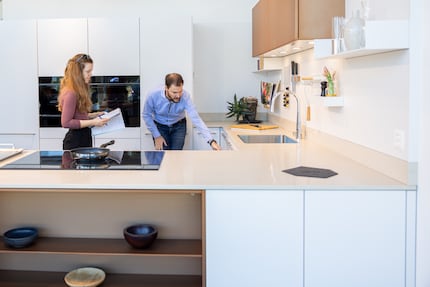
Source: Christian Walker
As for the magnetic vinegar and oil holder, the «twist» is a different one. Each bottle is designed to be taken out single-handedly, and the flap at the spout opens when you tilt it. Put it back, and the flap closes. «What’s more, the opening on the holder allows you to see how much is left in the bottle,» Joachim explains. The spice holders work on the same principle.
You can also get a holder for your cookbook or tablet. Joachim detaches it from the kitchen wall and snaps it back into place somewhere else. He does the same with a holder for kitchen utensils. Then, he detaches four additional hooks from it and says, «And just like that, you’ve got a towel rack! Many of our products are multifunctional.»
An eye for quality and details
But functionality isn’t everything. «You wouldn’t put a kitchen accessory on your countertop that’s practical but doesn’t look good. And you wouldn’t use one that looks good but isn’t practical. That’s why we consider functionality and design equally important,» explains Joachim. For this reason, the company relies on high-quality steel and stainless steel, as well as solid and FSC-certified walnut and oak wood. Eva demonstrates just how meticulous their attention to detail is: the logo is always at a right angle – to the wood grain. «Let’s take a look at the production now,» Eva says.
We leave the showroom and enter the huge manufacturing hall. Ten to twelve Forster steel kitchens are manufactured here each day. The production process is identical to that of the accessories. Everything starts with a kind of stencil, onto which the individual parts are drawn and then labelled. Production manager René Rensi shows how they’re punched out of a steel plate and bent into the right shape.
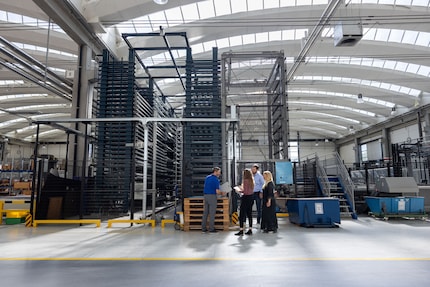
Source: Christian Walker
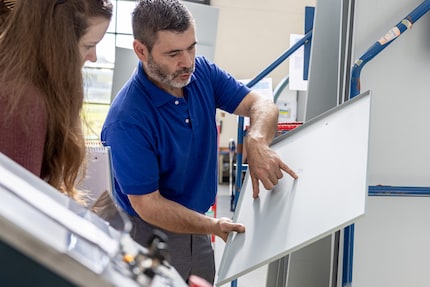
Source: Christian Walker
During welding, every corner is meticulously checked. Before the individual parts are glued together and pressed, they receive a high-quality powder coating. «The coating protects against corrosion and is particularly ecological because it doesn’t require any solvent,» René explains. «Our kitchens are also about 90 per cent recyclable.»
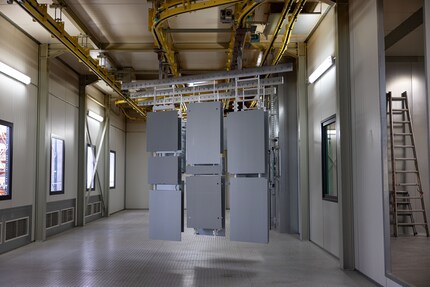
Source: Christian Walker
But there’s still room for improvement in terms of sustainability; as the machinery at the Arbon plant can’t make small angled parts, the kitchen accessories are manufactured in China. «Even though it’s very much a qualified manufacturer and we have an employee on site monitoring the entire process, we would, of course, prefer to produce in Switzerland,» admits Joachim. So what’s the problem? Well, there are hardly any Swiss companies able to combine all the work steps and materials under one roof. In addition, just about no one offers powder coating for such small individual parts. So far, Forster has only been able to find a Swiss production partner for the magnetic strips. However, talks are underway to find a good and affordable solution in Europe.
A magnetic attraction throughout the home
Forster’s kitchen accessories are meant to be affordable, though not quite cheap. For certain people, they’re priceless. Some customers are so inventive that they use the magnet strips and accessories not only in the kitchen, but also in the bathroom, living room and office. «Our accessories are designed for the entire home. Even for the garden – for example, as a hook for barbecue tongs. After all, grills are magnetic in and of themselves,» says Joachim.
I could just snap on the cookbook, washcloth and paper towel holder to the grill and... stop, Darina! Don’t get ahead of yourself. Even the most space saving of gadgets will eventually fill up your entire work surface. And then you’ll back where you started – annoyed about not having enough space.
Which kitchen accessory can you not go without? And which one do you find superfluous? Share your thoughts in the comments!
I love anything with four legs or roots - especially my shelter cats Jasper and Joy and my collection of succulents. My favourite things to do are stalking around with police dogs and cat coiffeurs on reportages or letting sensitive stories flourish in garden brockis and Japanese gardens.
Interesting facts about products, behind-the-scenes looks at manufacturers and deep-dives on interesting people.
Show all


